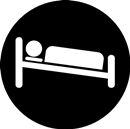Expert Review of Cardiovascular Therapy
May 2005, Vol. 3, No. 3, Pages 433-440
(doi:10.1586/14779072.3.3.433)
Combined hypertension and orthostatic hypotension in older patients: a treatment dilemma for clinicians
The combination of hypertension and orthostatic hypotension in older individuals is becoming increasingly recognized. Managing this combination of disorders presents a treatment dilemma – how to lower blood pressure to provide cardiovascular risk protection without predisposing to syncope. At present, there is no specific evidence base available with regard to managing such patients. Some antihypertensive drug classes (e.g., ?-blockers) appear more problematic in this regard than others. In the absence of controlled-trial evidence, use of antihypertensives with a more gradual onset of effect commenced at lower doses and use of lower-limb compression hosiery appears to be a reasonable approach. Abdominal compression devices and elevating the head of the bed may also help to combat orthostatic hypotenstion in older patients with hypertension and warrant future research.
Head-up sleeping improves orthostatic tolerance in patients with syncope.
2008 Dec;18(6):318-24. Epub 2008 Oct 15.
Head-up sleeping improves orthostatic tolerance in patients with syncope.
Cooper VL, Hainsworth R.
Cardiorespiratory Unit, St James's University Hospital, Leeds, UK.
OBJECTIVES: This study was designed to examine the effect of head-up sleeping as a treatment for vasovagal syncope in otherwise healthy patients. Treatment for syncope is difficult. Pharmacological treatments have potential side effects and, although other non-pharmacological treatments such as salt and fluid loading often help, in some cases they may be ineffective or unsuitable. Head-up sleeping may provide an alternative treatment. METHODS: Twelve patients had a diagnosis of vasovagal syncope based both on the history and on early pre-syncope during a test of head-up tilting and graded lower body suction. They then underwent a period of 3-4 months of sleeping with the head-end of their bed raised by 10 degrees , after which orthostatic tolerance (time to pre-syncope during tilt test) was reassessed. RESULTS: Eleven patients (92%) showed a significant improvement in orthostatic tolerance (time to pre-syncope increased by 2 minutes or more). Plasma volume was assessed in eight patients and was found to show a significant increase (P < 0.05, Wilcoxon signed-rank test). There was no significant change in either resting or tilted heart rate or blood pressure after head-up sleeping. INTERPRETATION: Head-up sleeping is a simple, non-pharmacological treatment which is effective in the majority of patients. However, it may not be tolerated by patients or bed-partners long term and whether the effects continue after cessation of treatment remains to be determined.
Gravity, Learn to live with it, because you can't live without it!
 Inclined Bed Therapy: Sleeping Inclined To Restore and Support Your Health For Free. Fascinating Science, Discovery, History and Medical Research In Circulation And Posture, by Andrew K Fletcher. Read the Success Stories. Check the Forum.
Inclined Bed Therapy: Sleeping Inclined To Restore and Support Your Health For Free. Fascinating Science, Discovery, History and Medical Research In Circulation And Posture, by Andrew K Fletcher. Read the Success Stories. Check the Forum.